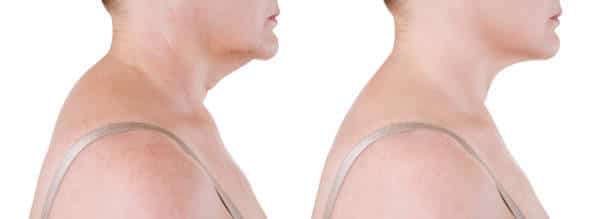Dealing with a neck hump, also known as a Buffalo hump, can be a discomforting experience with potential health implications.
This condition, characterized by fat accumulation at the back of the neck between the shoulder blades, can result from various factors such as poor posture, aging, or underlying health issues like osteoporosis or arthritis.
The impact of a neck hump extends beyond aesthetics, potentially causing strain on spinal disks, upper and lower back pain, and tightness in the legs. Understanding the causes and addressing them through corrective measures is crucial for enhancing both physical well-being and posture. In this guide, we’ll explore effective ways to get rid of a neck hump and promote overall neck health.
What Is a Neck Hump
A Neck Hump, sometimes referred to as a Buffalo hump, is something that most of us have most likely seen or even experienced.
A build-up of fat between the shoulder blades on the back of the neck can lead to aging, poor posture, and even some diseases.
Both physical and mental health can suffer from bad posture.
Chronically slouching with your back hunched forward is not attractive and strains your back muscles more than necessary.
If you have a neck hump you may also experience these symptoms:
- The strain on our spinal disks
- Upper and lower back pain
- Difficulty with tightness in the legs
What Causes a Neck Hump?
Here are some causes of neck hump that can help you correct these mistakes and get back to your regular neck.
Osteoporosis
Osteoporosis is a condition that may result in a compression fracture in the spine, leading to a noticeable outward curvature of the upper back, commonly referred to as a hunchback. This curvature occurs because the fracture causes an increased forward curve, necessitating the pulling back and up of the head to maintain a forward gaze.
Maintaining bone health is crucial in preventing conditions like osteoporosis, and incorporating a high-quality multivitamin, such as “All in One Multivitamin,” into daily routines can support overall well-being.
Scheuermann’s Kyphosis
Scheuermann’s Kyphosis, although less common, involves the spine developing incorrectly, possibly even before birth. This condition, appearing in teens, causes the spine to form into a wedge rather than a rectangle shape.
Arthritis
Arthritis is another factor contributing to a neck hump, often resulting from the body compensating for chronic neck pain associated with arthritis. Over time, worsening pain can lead to increased hunching and curving of the upper thoracic spine. Lower neck arthritis may cause the head to naturally lean forward for comfort.
Aging
Contributes to significant loss of mass in spinal vertebrae, leading to postural changes that accentuate any existing hump.
Excess fat
Stored around the neck’s upper back region can also present as a “hump.” Regardless of the cause, managing this hump requires awareness of standing and sitting positions to maintain body balance.
How To Get Rid Of Neck Hump: Best Exercise
Neck humps can be hard on everybody, so to relieve yourself from this issue, you need to give these exercises a swift go and then see the perfect solution for your neck.
1. Shoulder Rolls
An obvious hump on the back of your neck can cause troublesome conditions like bad posture and persistent pain.
Fortunately, this easy exercise can help relieve that hunch in your neck by releasing tension in the front and rear of your shoulders. This activity can be executed whenever and wherever you choose, without requiring any specialized gear or a gym membership.
To Do It:
- Start by standing upright and keeping your arms at your sides.
- Then, roll your shoulders 12 times in every direction, both forward and backward.
- Take a little rest and return to three more cycles.
2. Neck Flexion
Neck flexion is a pivotal motion that entails reducing the angle between the neck and the chest, essentially bending the head forward.
This movement holds significance as it plays a vital role in strengthening the neck muscles, thereby contributing to improved posture, alleviation of neck pain, and overall enhancement of neck health.
For effective neck flexion exercises, the Neck Harness proves to be an outstanding tool. Crafted from durable materials capable of withstanding heavy weights, it ensures a prolonged and secure workout experience.
The adjustable straps enable a personalized fit for comfort, while the padded interior provides additional support to prevent strain.
To Do It:
- First off, put the neck harness on your head and make sure it fits snugly. Adjust it if you need to.
- Stand or sit up straight. Keep your back straight and your feet about as wide apart as your shoulders.
- Start the exercise by slowly bending your head down until your chin touches your chest. Don’t rush it and keep your neck and back straight.
- Now, slowly lift your head back up until you’re looking straight ahead again.
- Do this over and over again.
Related Article: How to Use Neck Head Harness
3. Diagonal Band Stretch
If you want to improve your posture and strengthen your back and shoulders, there’s an awesome three-directional exercise that can do just that. It promotes thoracic extension, which helps straighten up any rounded backs, and you’ll feel it in the middle of your spine – exactly where most people need more support.
To Do It:
- Take a Resistance Band and stretch it diagonally with your hands facing the opposite way while you grip either end.
- Then, change the direction and stretch the band across your chest horizontally to complete the action.
- Finally, keep your thumbs up, relax your neck and push your shoulder blades together while you tug on the band.
4. Neck Extension
To Do It:
- Put the neck harness on your head and make sure it fits just right.
- Stand or sit straight. Keep your back lined up and your feet about as wide as your shoulders.
- Start the exercise by slowly leaning your head backward, going against the resistance of the Bumper Plates. Keep control and make sure your neck and back stay straight.
- Now, slowly bring your head forward again until you’re looking straight ahead, still resisting the harness.
- Do this as many times as you feel comfortable with.
5. Wall Extension Stretches
To Do It:
- Touch the wall using both hands.
- Hinge your hips backward while keeping a straight back, and slowly lower your chest to the ground.
- Avoid dragging your head toward the ground and maintaining it parallel to your spine.
- Keep your mid back and chest straight, so they feel the stretch.
- This move will loosen your chest muscles and mobilize your midback’s rigid spine.
- Repeat 10 times.
Doing this simple stretching sequence a few times daily can make a big difference for those trying to cope with or reduce their neck hump over time.
6. Thoracic Mobilization on a Ball
To Do It:
- Kneel on the ground with your arms in front of you on the ball.
- Put your forehead between your arms.
- Gradually open your arms and let your head fall towards the ground.
- Keep the area between your shoulder blades as you lean towards the ground.
- Maintain your neck neutrally with no strain.
- Inhale and feel a stretch in your upper back.
- Make 10-15 repetitions.






